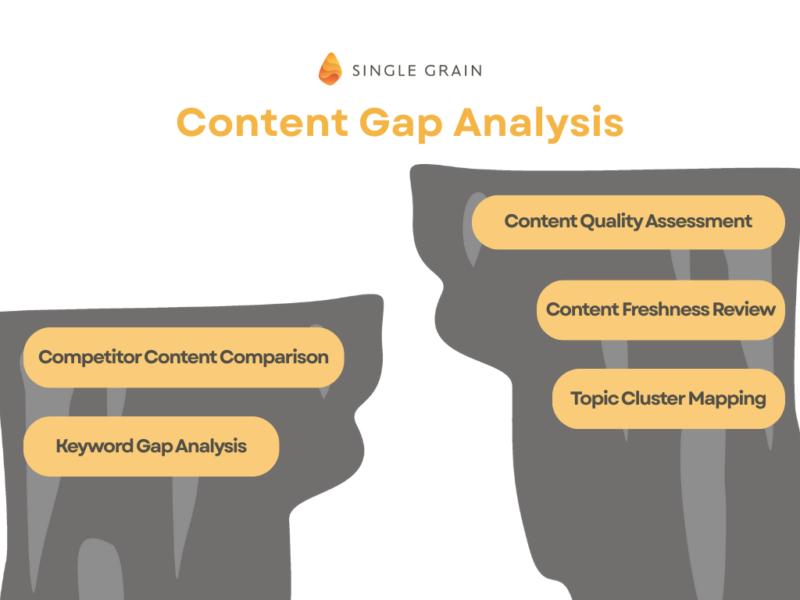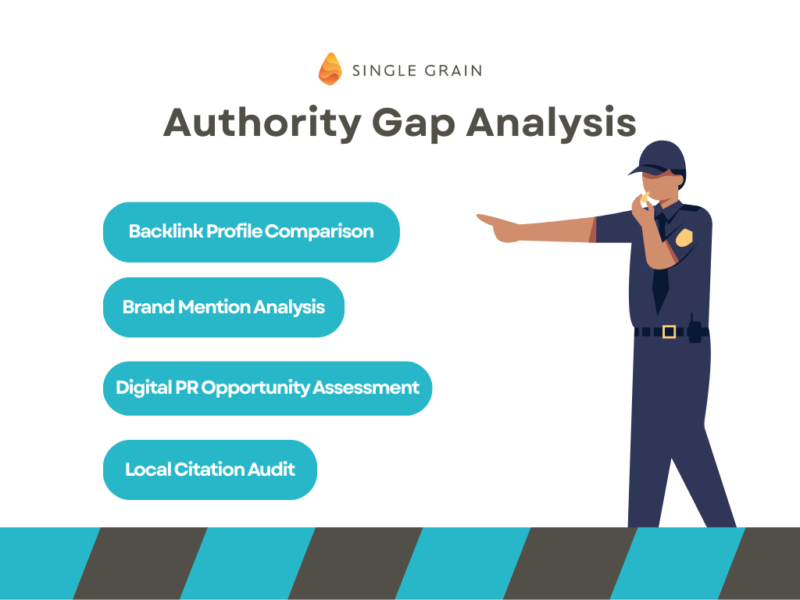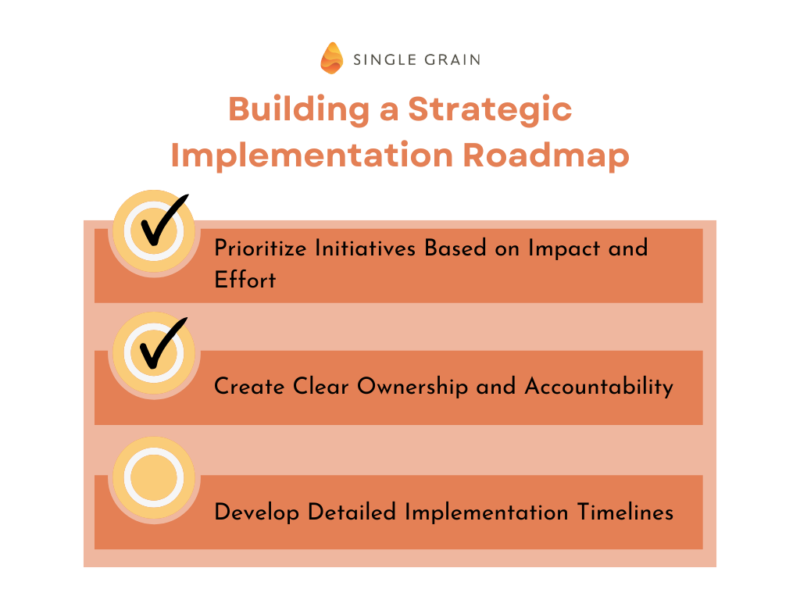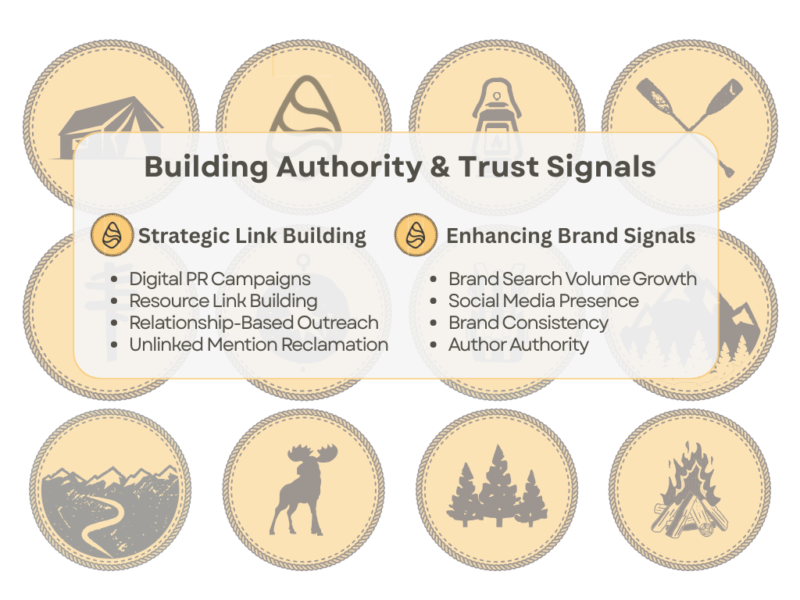Close the SEO Gap: Turn Strategy into Real Results
In the rapidly evolving search engine optimization landscape, many businesses are found caught in a frustrating cycle. They invest in developing comprehensive SEO strategies, yet struggle to translate these plans into measurable results. This disconnect between strategy and execution—what we call the “SEO gap”—prevents organizations from realizing the full potential of their organic search efforts. This article provides a practical framework for bridging this gap, turning your SEO strategy from theoretical concepts into tangible business outcomes.
Key Takeaways
- The average SEO strategy implementation achieves only 37% of its potential value due to execution gaps
- Successful SEO implementation requires alignment across technical, content, and authority building efforts
- Content gap analysis comparing your site to top competitors reveals critical opportunities for growth
- Topic clusters have replaced keyword-focused approaches as the foundation of effective SEO content strategy
- Technical SEO issues can undermine even the best content strategy if left unaddressed
- Conversion rate optimization is essential for turning increased traffic into business results
- Regular measurement and adaptation are crucial for long-term SEO success
- Cross-functional collaboration between SEO, content, development, and business teams is vital for closing the implementation gap
TABLE OF CONTENTS:
Understanding the Strategy-Execution Gap in SEO
The disconnect between SEO strategy and implementation is a widespread challenge. According to recent industry research, the average SEO strategy achieves only about 37% of its potential value due to execution gaps.
This shortfall occurs for several key reasons:
Siloed Organizational Structures
In many organizations, the teams responsible for SEO strategy operate separately from those handling implementation. SEO experts develop plans, but content creators, web developers, and business stakeholders may not fully understand or prioritize these initiatives.
Lack of Clear Implementation Roadmaps
Even well-conceived strategies often lack detailed execution plans that break down complex SEO initiatives into manageable tasks with clear ownership and timelines.
Insufficient Resources and Expertise
Many organizations underestimate the resources required to properly implement SEO strategies, particularly in content creation, technical optimizations, and link-building efforts.
Inadequate Measurement and Adaptation
Without proper tracking and analysis, organizations struggle to identify what’s working and what needs adjustment, leading to wasted efforts and missed opportunities.
“The biggest SEO challenge isn’t knowing what to do—it’s actually doing it consistently and effectively,” notes Adam Heitzman, SEO expert. “The companies that excel are those that bridge the gap between strategy and execution.”
Conducting an Effective SEO Gap Analysis
Before bridging the SEO gap, identify the existing disconnects between your current performance and your potential. A comprehensive SEO gap analysis provides this critical foundation.
Technical SEO Gap Analysis

Start by evaluating the technical foundation of your website, as technical issues can undermine even the best content strategy:
- Site Speed Assessment: Analyze page load times across devices using tools like Google PageSpeed Insights or GTmetrix. Identify specific elements causing delays.
- Mobile Optimization Check: Ensure your site provides an optimal experience across all devices, with particular attention to mobile usability issues.
- Indexation Analysis: Review your site’s crawlability and indexation status through Google Search Console. Identify pages that should be indexed but aren’t.
- Schema Implementation Review: Assess your structured data implementation and identify opportunities to enhance rich snippet visibility.
- Core Web Vitals Evaluation: Measure your performance against Google’s Core Web Vitals metrics, which directly impact rankings.
Content Gap Analysis

Content gaps represent some of the most significant opportunities for SEO improvement:
- Competitor Content Comparison: Analyze the top 3-5 competitors in your space to identify topics they cover comprehensively that you’re missing entirely.
- Keyword Gap Analysis: Use tools like Semrush or Ahrefs to identify high-value keywords where competitors rank but you don’t.
- Content Quality Assessment: Evaluate existing content against current search quality standards, particularly regarding expertise, authoritativeness, and trustworthiness (E-A-T).
- Content Freshness Review: Identify high-potential pages that haven’t been updated in six months or more.
- Topic Cluster Mapping: Assess how well your content is organized into comprehensive topic clusters that signal subject matter expertise to search engines.
Authority Gap Analysis

Backlink and authority metrics remain crucial ranking factors:
- Backlink Profile Comparison: Compare your backlink profile to top competitors, identifying gaps in both quantity and quality.
- Brand Mention Analysis: Evaluate unlinked brand mentions that could be converted into valuable backlinks.
- Digital PR Opportunity Assessment: Identify industry publications and influencers where your competitors have secured coverage that you haven’t.
- Local Citation Audit: For businesses with physical locations, analyze local citation consistency and completeness compared to competitors.
Single Grain’s SEO services include a comprehensive gap analysis that identifies your most significant opportunities for improvement across technical, content, and authority dimensions.
Building a Strategic Implementation Roadmap

Once you’ve identified your SEO gaps, the next step is developing a clear roadmap that transforms strategy into actionable tasks. This roadmap should:
Prioritize Initiatives Based on Impact and Effort
Not all SEO opportunities are created equal. Your implementation roadmap should prioritize initiatives based on:
- Potential Traffic Impact: Estimate the traffic potential of each initiative based on search volume and competitive difficulty.
- Revenue Potential: Consider the conversion potential and average traffic value (ATV) from different keyword clusters.
- Implementation Complexity: Assess the technical difficulty and resource requirements for each initiative.
- Time to Impact: Estimate how quickly each initiative will begin showing results.
This prioritization ensures you focus on high-impact, efficient opportunities first, creating momentum for your SEO program.
Create Clear Ownership and Accountability
Effective implementation requires clear ownership across different functional areas:
- Technical SEO Tasks: Assign to web development or IT teams with specific deliverables and deadlines.
- Content Creation and Optimization: Establish clear responsibilities for content teams, including production schedules and quality standards.
- Link Building and PR Initiatives: Assign to digital PR specialists or agencies with specific targets.
- Analytics and Reporting: Designate responsibility for tracking progress and reporting results.
Develop Detailed Implementation Timelines
Break down your SEO roadmap into specific phases with clear timelines:
- Quick Wins (1-30 days): Focus on high-impact, low-effort optimizations that can show immediate results.
- Medium-Term Initiatives (1-3 months): Address more complex technical issues and begin implementing content strategies.
- Long-Term Projects (3-12 months): Develop comprehensive topic clusters and authority-building campaigns.
Executing Technical SEO Fundamentals
Technical SEO provides the foundation upon which all other optimization efforts build. Without a technically sound website, even the best content strategy will underperform.
Optimizing Site Speed and Core Web Vitals
Site speed has become increasingly important as a ranking factor, particularly with the introduction of Core Web Vitals as part of Google’s page experience signals:
- Image Optimization: Implement next-gen formats like WebP, proper sizing, and lazy loading.
- JavaScript Optimization: Minimize and defer non-critical JavaScript.
- Server Response Time Improvement: Upgrade hosting if necessary and implement caching.
- CSS Optimization: Minimize CSS, remove unused styles, and inline critical CSS.
- Font Optimization: Use system fonts where possible or properly optimize web fonts.
Enhancing Mobile Experience
With mobile-first indexing fully implemented, mobile optimization is no longer optional:
- Responsive Design Implementation: Ensure your site adapts seamlessly to all screen sizes.
- Touch Element Spacing: Ensure buttons and links are properly sized and spaced for touch interaction.
- Content Parity: Maintain the same content across mobile and desktop versions.
- Mobile Page Speed: Specifically optimize for mobile network conditions.
Implementing Structured Data
Structured data helps search engines understand your content and can enhance your search appearance:
- Core Schema Implementation: Add organization, breadcrumb, and website schema to all pages.
- Page-Specific Schema: Implement article, product, FAQ, how-to, or other relevant schemas based on content type.
- Local Business Schema: For businesses with physical locations, implement comprehensive local business markup.
- Testing and Validation: Regularly test structured data implementation using Google’s Rich Results Test.
Implementing Content Strategy for Maximum Impact
Content remains at the heart of SEO success, but the approach to content optimization has evolved significantly in recent years.
Building Comprehensive Topic Clusters
The days of targeting individual keywords with individual pages are over. Modern SEO content strategy revolves around topic clusters:
- Pillar Content Development: Create comprehensive guides that broadly cover main topics relevant to your business.
- Supporting Content Creation: Develop specialized content that addresses specific aspects of each topic in depth.
- Internal Linking Structure: Connect supporting content to pillar pages with descriptive anchor text.
- Content Hierarchy: Establish clear information architecture that signals topic relationships to search engines.
Optimizing for Search Intent
Understanding and addressing user intent has become crucial for content success:
- Intent Classification: Categorize target keywords by intent (informational, navigational, commercial, transactional).
- Content Format Alignment: Match content format to intent (guides for informational, product pages for transactional, etc.).
- SERP Feature Targeting: Optimize content to capture relevant SERP features based on intent (featured snippets, knowledge panels, etc.).
- User Journey Mapping: Create content that addresses different stages of the buyer’s journey.
Refreshing Existing Content
Content refreshes often provide faster results than creating new content:
- Performance Analysis: Identify underperforming pages with potential based on current rankings and search volume.
- Competitive Gap Analysis: Compare your content to higher-ranking competitors to identify improvement opportunities.
- Content Consolidation: Merge similar or thin content into more comprehensive resources.
- Freshness Signals: Update statistics, examples, and references to maintain relevance.
Single Grain’s content marketing services can help you develop and implement a comprehensive content strategy that aligns with your SEO goals.
Building Authority and Trust Signals

While technical optimization and content creation form the foundation of SEO, authority signals remain crucial for competitive rankings.
Strategic Link Building
Modern link building focuses on quality, relevance, and natural acquisition:
- Digital PR Campaigns: Develop newsworthy content that naturally attracts links from publications.
- Resource Link Building: Create valuable industry resources that serve as reference materials.
- Relationship-Based Outreach: Build genuine relationships with industry publishers rather than sending mass emails.
- Unlinked Mention Reclamation: Identify and convert brand mentions into actual links.
Enhancing Brand Signals
Google increasingly considers brand signals in its ranking algorithms:
- Brand Search Volume Growth: Implement marketing initiatives that increase branded search queries.
- Social Media Presence: Maintain active, engaged social profiles that reinforce brand authority.
- Brand Consistency: Ensure consistent name, address, and phone information across the web.
- Author Authority: Highlight content creators’ expertise and credentials to enhance E-A-T signals.
Measuring Success and Adapting Strategy
Effective measurement is essential for closing the SEO gap, allowing you to identify what’s working, what isn’t, and where adjustments are needed.
Establishing Meaningful KPIs
Focus on metrics that truly matter to your business:
- Organic Traffic Growth: Track overall organic traffic and segment by landing page and topic cluster.
- Keyword Visibility: Monitor rankings for priority keywords and topic areas.
- Organic Conversion Rate: Measure how effectively organic traffic converts to leads or sales.
- Revenue Attribution: Attribute revenue to organic traffic sources when possible.
- Return on SEO Investment: Calculate the ROI of your SEO efforts based on attributed revenue.
Implementing Regular Reporting Cadences
Establish consistent reporting processes that drive action:
- Weekly Performance Checks: Monitor key metrics for significant changes or issues.
- Monthly Deep Dives: Analyze performance trends and adjust tactical priorities.
- Quarterly Strategic Reviews: Evaluate overall strategy effectiveness and make larger adjustments as needed.
Adapting to Algorithm Updates and Industry Changes
The SEO landscape continues to evolve rapidly:
- Algorithm Update Monitoring: Track major Google updates and assess their impact on your performance.
- Competitive Analysis Refreshes: Regularly reassess competitor strategies and performance.
- Industry Trend Adaptation: Stay informed about emerging SEO trends and adjust strategy accordingly.
Integrating SEO with Broader Marketing Efforts
To successfully close the SEO gap, you must integrate your optimization efforts with other marketing channels and business objectives.
Aligning SEO with Content Marketing
Content marketing and SEO should operate as complementary disciplines:
- Unified Content Calendar: Develop content plans that serve both SEO and broader content marketing goals.
- SEO Input on Content Briefs: Ensure SEO requirements are incorporated into all content creation briefs.
- Content Performance Measurement: Evaluate content based on both engagement metrics and SEO performance.
Coordinating SEO and Paid Search
SEO and paid search can work together to maximize search visibility:
- Keyword Gap Coverage: Use paid search to cover valuable keywords with weak organic rankings.
- SERP Real Estate Domination: Target simultaneous organic and paid visibility for high-value terms.
- Data Sharing: Use paid search data to inform SEO keyword targeting and vice versa.
Integrating SEO with Conversion Rate Optimization
Traffic without conversions has limited business value:
- Landing Page Optimization: Continuously test and improve key landing pages from organic search.
- User Journey Analysis: Identify and address friction points in the conversion path for organic visitors.
- Personalization: Implement content personalization based on search intent signals.
Single Grain’s CRO services can help you maximize the value of your organic traffic through systematic conversion optimization.
Overcoming Common Implementation Challenges
Even with a solid roadmap, several common challenges can impede SEO implementation. Here’s how to address them:
Securing Executive Buy-In and Resources
SEO often competes with other initiatives for resources and attention:
- Business Impact Forecasting: Develop clear projections of traffic and revenue impact from SEO initiatives.
- Competitive Benchmarking: Demonstrate how competitors are gaining advantage through SEO investments.
- Quick Win Showcasing: Implement small, high-impact optimizations to demonstrate potential.
- Education: Help executives understand the strategic importance of SEO in the current search landscape.
Managing Cross-Functional Collaboration
SEO implementation typically requires coordination across multiple teams:
- Clear Process Documentation: Develop clear workflows for SEO implementation across departments.
- Regular Cross-Functional Meetings: Establish consistent touchpoints between SEO, content, development, and business teams.
- Shared Goals and Metrics: Align team objectives around common SEO outcomes.
- Training and Knowledge Sharing: Ensure all stakeholders understand SEO fundamentals relevant to their roles.
Maintaining Momentum and Consistency
SEO requires sustained effort over time:
- Implementation Tracking: Use project management tools to track SEO tasks and maintain accountability.
- Regular Progress Reviews: Conduct consistent check-ins on implementation status and results.
- Celebration of Wins: Recognize and share successes to maintain team motivation.
- Continuous Learning: Invest in ongoing education to keep teams updated on evolving best practices.
Case Study: Closing the SEO Gap in Action
To illustrate how these principles work in practice, consider this case study of a B2B software company that successfully closed their SEO gap:
Initial Situation
The company had invested in developing a comprehensive SEO strategy but was seeing minimal results after six months. Their key challenges included:
- Technical issues preventing proper key content indexation
- Siloed content creation process with minimal SEO input
- Lack of clear ownership for SEO implementation tasks
- Inconsistent measurement and reporting
Implementation Approach
The company took the following steps to close their SEO gap:
- Comprehensive Gap Analysis: Conducted a thorough audit of technical, content, and authority gaps compared to competitors.
- Cross-Functional Implementation Team: Established a dedicated team with representatives from SEO, content, development, and business leadership.
- Prioritized Roadmap: Developed a phased implementation plan prioritizing critical technical issues, then high-potential content opportunities.
- Clear Ownership and Timelines: Assigned specific owners and deadlines for each implementation task.
- Regular Progress Reviews: Implemented weekly status updates and monthly performance reviews.
Results
Within six months of implementing this approach, the company achieved:
- 143% increase in organic traffic
- 67% improvement in conversion rate from organic traffic
- 94% increase in revenue attributed to organic search
- Visibility for 72% more keywords in the top 10 positions
This transformation came not from changing their strategy, but from systematically closing the gap between strategy and implementation.
From Strategy to Results
Closing the SEO gap requires more than knowing what to do—it demands systematic execution across technical, content, and authority-building dimensions. By conducting thorough gap analysis, creating detailed implementation roadmaps, and addressing common execution challenges, you can transform your SEO strategy from a theoretical document into a powerful driver of business results.
The most successful organizations treat SEO as a continually ongoing improvement program. They establish clear implementation, measurement, and adaptation processes, ensuring their SEO efforts evolve alongside search engine algorithms and user behaviors.
Ready to close your SEO gap? Contact Single Grain to learn how our comprehensive SEO services can help you transform strategy into measurable results.
The post Close the SEO Gap: Turn Strategy into Real Results appeared first on Single Grain.


